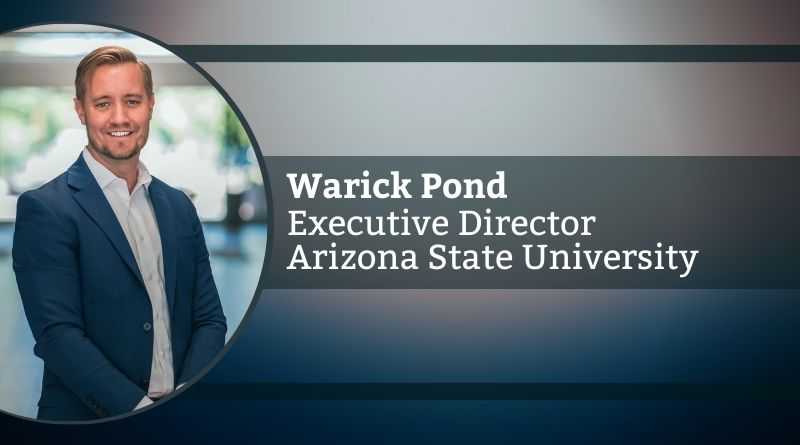Rethinking Shared Decision Models for Inclusive Technology Transformation in Higher Education
By Warick Pond, Executive Director, Arizona State University
In the face of rapidly evolving technology and the need for inclusive digital transformation across universities, the urgency of making timely decisions about technology cannot be underestimated.
As modern universities rely on technology to advance and transform their operations, it is imperative that these decisions be inclusive and considerate of the diverse needs of all students, faculty and staff. Any technology-based decisions should aim to support and empower individuals from all backgrounds.
In higher education, the process of making technology-based decisions can be complex and time-consuming, often involving committees and resulting in slower-than-desired implementation and adoption of widespread technology initiatives.
In an effort to address these challenges, Arizona State University (ASU) has implemented an approach to shared decision-making modelsthat prioritizes inclusion without sacrificing speed. These efforts have yielded numerous benefits, including:
- Reduction of implementation friction
- Increased business/functional engagement in technology decisions
- Increased executive technical knowledge
- IT having a “seat at the table” for business decisions
- Alignment of strategies/goals
- Ability to pivot quickly based on market realities
- Antifragility built within organizational operations
Recognized as the most innovative university for eight years and counting, ASU embraces emerging technology and plays an active role in shaping the growing digital education landscape and society at large.
The university envisions an agile, responsible technology infrastructure that aligns with our enterprise strategy, driving opportunity and scalable adoptions across the ASU network. ASU’s Enterprise Technology model – which is responsible for advancing the university’s dynamic digital ecosystem – strikes a balance between two main areas of focus:
- Alignment aligning business and organizational IT strategy and orchestration of enterprise-wide technology transformation investments, including organizational development and culture, information security and trust, IT partnerships, projects and programs.
- Experience We provide students, faculty and researchers with cutting-edge, technology-driven experiences to spark innovation and connectivity within and outside the ASU community.
Under this model, our department has become a network of technologists who enable seamless experiences across ASU enterprises. This model recognizes the importance of meeting the specific needs of various university chapters while also providing support for the ASU network as a whole.
Designed with the participation of leaders across disciplines, the three “pillars” form the foundation of ASU’s efforts: the Academic Enterprise, focused on student success; the Knowledge Enterprise, dedicated to advancing research; and the Learning Enterprise, ASU’s ecosystem for lifelong learning. The university’s realignment combines access, technology and personalization to support the success of students and partners.
Our leaders make strategic technology decisions, investments, and pivots together rather than having a central technology group having to balance a multitude of possibly conflicting needs.
ASU’s Enterprise Technology supports business and community collaboration for success
Our IT model balances the need for scale and personalization in providing various tech-based and IT services to the ASU community — empowering teams to utilize technology to achieve their goals and manage innovation effectively.
Moreover, Enterprise Technology is actively developing an enterprise-wide model to manage innovation and budgeting in utility service areas. This holistic approach allows ASU’s enterprises to maximize the benefits of technology for the entire university.
ASU’s Public Enterprise model is supported by the following value propositions:
- Alignment: Bringing together business and academic IT leadership for a holistic view of needs
- Agility: Creating direct feedback loops and IT processes to quickly adapt to current needs
- Antifragility: Fostering digital dexterity to thrive through radical changes and disruptions
- Creativity: Integrating and amplifying voices across the institution for greater representation and inclusion in our strategies
- Scalability: Democratizing digital to infinitely expand access and equity

Enterprise Technology is focusing on leveraging existing resources across enterprises and exploring new opportunities for growth to support larger initiatives. This shift away from a central model allows for more flexibility to support future collaboration, innovation and sustainability.
The success of the model depends on effective alignment throughout the enterprises. To achieve this, Enterprise Technology has assembled a team of cross-ASU members, known as liaisons, representing all three ASU enterprises. These liaisons meet regularly to prioritize, fund and implement shared technology initiatives that provide consistent experiences across ASU while also balancing scale and personalization.
The Liaison group shares its technology priorities with a Distributed Technology group comprising IT leaders within specific units. The model enables a top down and bottom up approach to sharing and identifying technology needs and priorities across the entirety of ASU.
The Technology Management Council, chaired by ASU’s CIO and consisting of the Executive Vice President, the COO, and the CFO, is responsible for validating technology investment priorities at ASU. The model provides flexibility in technological priorities and can pivot quickly if necessary. Both the Technology Management Council, the Liaisons and the Distributed Technology groups are closely aligned with Portfolio Owners who oversee the tactical and operational efforts.
Our leaders make strategic technology decisions, investments, and pivots together rather than having a central technology group having to balance a multitude of possibly conflicting needs. With varied and diverse needs and perspectives, an inclusive decision model is necessary.
Ensuring a shared decision model has provided secondary benefits:
- Demonstrates increased collaboration, transparency and communication between and across the ASU IT community
- Encourages shared strategies, culture, projects, resourcing and invites robust participation across the enterprise
- Addresses how to scale and equitably fund enterprise IT activity to ensure the best use of ASU’s assets
- Aligns around the ASU talent pipeline, leveraging the major technology sector growth in the Phoenix metropolitan area
Using an inclusive and collaborative model, Enterprise Technology has discovered opportunities to advance tech-enabled architecture, design, and resources. This holistic approach empowers ASU’s Public Enterprises to strategize and scale technology priorities throughout and beyond the university.
Moving forward, ASU enterprises will continue to make great strides to enhance the decision-making process to create opportunities for emerging technology to transform the university for a digital future.

